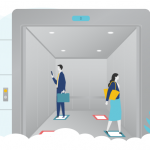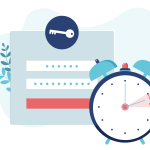The Impact of Change Fatigue—and How to Overcome It
March 16, 2023

The world has been in a state of constant flux ever since the onset of the pandemic. This is particularly evident when it comes to the workplace, which has seen significant shifts over the past few years. We’ve come a long way from the sudden transition to remote work. But with the lifting of social distancing restrictions and the challenges of virtual collaboration, some employers are now mandating a return to the office, while others are implementing hybrid work policies.

However, research shows that only about 54% of organizational change initiatives are successful. Why? Although change can often bring growth and opportunity, experiencing too much change in a short amount of time can be harmful. This effect is called change fatigue, which can be detrimental not just to individuals, but also to teams and organizations. Most people tend to prefer routine, structure, and predictability—and with more change, comes more stress and uncertainty, which leads to tired and unmotivated employees.
So what exactly is change fatigue? How does it impact the workplace? And most importantly, what can we do to overcome it?
What is change fatigue?
Change fatigue refers to the sense of exhaustion, disillusionment, and frustration that can arise when an individual or group is continually subjected to significant changes, especially during a brief period of time. In the workplace, it is characterized by feelings of passive indifference, resistance, or even cynicism toward organizational changes, and can lead to increased stress, decreased productivity, and burnout.
Some of the most common situations that cause change fatigue include, but are not limited to: organizational restructuring, leadership transitions, implementation of new technologies, as well as external disruptions, like a recession or a pandemic. Change fatigue tends to be more prevalent when changes are imposed on individuals or groups without sufficient communication, support, or involvement in the change process.
RELATED: Work, Sleep, Eat, Repeat: Managing the Burnout Crisis
What’s the impact on your employees?
Amid ongoing digital evolution and economic turbulence, many organizations are putting emphasis on change management as a means of navigating constant disruption. But due to the effects of change fatigue, employees are more likely to disengage and lose the willingness to accommodate these changes, which ultimately results in higher levels of employee absenteeism and turnover.
It’s important to recognize the constraints of the human brain in terms of processing and adapting to changes, particularly in knowledge-based industries that rely heavily on the mental capacity of their workforce. Only a small fraction of our brain cells are dedicated to cognitive flexibility and adjusting to our surroundings, and employees will instinctively resist new changes once they’ve reached the point of change saturation.
RELATED: What does turnover have to do with business liability?
What’s the impact on the workplace?
Change fatigue creates a sense of apathy to problems within the workplace and a loss of confidence in institutions. Employers often don’t realize that absenteeism, low engagement, and high employee turnover may be tied directly to change fatigue in their organization. Only 43% of employees who experience above-average change fatigue intend to stay with their organization. That means 57% of them are looking to leave—and many of these could be your best people!
In knowledge-based industries, the impact of stress and change fatigue has a higher-than-average impact on an organization’s resilience and ability to execute, due to its reliance on people and their cognitive abilities. High stress often leads to discontentment and employee performance issues—then what? Mistakes, missed deadlines, unhappy clients, and maybe even disgruntled employees, alleging that their performance was a result of a high-stress environment. All of these things could potentially lead to a lawsuit on your hands, whether it’s a professional liability, mismanagement, or employment-related claim.
RELATED: How much will a bad hire really cost your business?
PRO Tips for Managing Change Fatigue
When times are unpredictable, organizations have an opportunity to re-examine their approach to their employees and build adaptability into the fabric of their culture.
To achieve this, businesses should consider embracing a human-centric leadership model and creating an environment where employees feel valued, and leaders work collaboratively with team members to facilitate positive change. Here are our top tips to help you get started on the path to overcoming change fatigue:
1. Build strong team relationships.
Managers can help prevent change fatigue by developing trust and cohesion between team members. In the face of changing circumstances, having a solid support system in the workplace helps employees feel reassured and stay grounded, even while constantly adapting. Humans are innately social creatures, and having strong relationships at work can make all the difference when it comes to higher job satisfaction and lower employee turnover rates.
RELATED: 10+ Tips for Talent Retention
2. Be transparent in your communication.
Keeping employees informed is the key to effective change management—even bad news is better than no news. Be sure to explain the reasoning behind the change, and what it will mean for the individual and the organization as a whole. Maintaining consistent communication can help alleviate the burden of stress and anxiety that comes with being in a state of uncertainty.
Taking transparency one step further and actively involving employees in the change process is a great way to further reduce change fatigue. Organizations that implement open-source change strategies rather than traditional top-down change strategies are 14x times more likely to achieve change success.
3. Have empathy for employees.
82% of employees say it’s important for their organization to see them as a person, not just an employee—but only 45% of employees believe their organization actually sees them this way. When a leader makes a genuine effort to display empathy and compassion towards their employees, they’re far more likely to gain the trust of their team. Provide opportunities for team members to connect with upper management, and make sure they’re always being listened to.
Employees who have trust in their leaders are less likely to respond negatively to organizational changes. To be an effective leader, take the necessary steps to ensure that your team feels supported and encouraged throughout any changes—this will mitigate the effects of change fatigue.
4. Prioritize wellness.
In times of significant change, the energy required to make decisions—or just conduct business as usual—can be especially draining. Staying in touch with simple acts of wellness can help to maintain resilience and reduce change fatigue, like incorporating movement and nature into your day, eating healthy, sleeping well, and taking part in wellness programs offered by the organization.
Leaders should encourage and model behaviours such as signing off after work hours, using paid time off, and taking breaks whenever needed. 52% of employees say flexible work policies will affect their decision to stay at their organizations—flexibility is crucial to promoting overall wellness, allowing employees to work effectively without worrying about not being able to fulfill personal obligations, such as healthcare appointments, childcare, and eldercare.
5. Enhance employee benefits.
The success of an organization relies on the well-being of its people. When employees feel healthy and supported by their leaders—businesses become more resilient in the face of an uncertain future.
Be sure to implement benefits that meet the needs of your workforce. Monitor employees’ engagement and readjust as needed. Consider solutions that go beyond traditional offerings, like:
- Free subscriptions to mental health apps and platforms;
- Access to virtual exercise, meditation classes, and fitness and nutrition coaches;
- Financial counselling services;
- Subsidized child- or eldercare programs or new parent support;
- Group benefits plans and Health & Dental Insurance to help employees pay for costs that provincial health care plans won’t cover; and
- Employee Assistance Programs (EAPs) that provide access to licensed mental health professionals and counsellors;
- And more.
Most importantly, make sure it’s easy to access help—ensure all programs are visible, affordable, and accessible. Encourage employees to familiarize themselves with the resources available and make use of them whenever they feel stressed or overwhelmed.
RELATED: How can group benefits help my small business?
6. Strengthen business insurance coverages.
The stress that comes with change fatigue may lead to performance issues, which can result in professional liability lawsuits from clients when they feel that your business was negligent or didn’t deliver services as expected. It can also lead to employment liability lawsuits from disgruntled former employees who were dismissed due to poor performance.
Even if your organization hasn’t had a management claim before, you can’t predict when a choice you made in the regular course of work could result in a lawsuit. Covering all your bases with the right insurance policies will help you avoid financial strain and ensure that one misstep won’t jeopardize your business.
- Professional Liability Insurance (E&O): Protects you (and your business) from any allegations of errors, omissions, or negligence committed within the scope of your professional activities.
- Directors & Officers Insurance (D&O): Protects your business leaders and board members if they’re personally sued for any actual or alleged wrongful acts in managing the company.
- Employment Practices Liability Insurance (EPL): Protects your business from claims made against you by past and present employees, including performance and promotion disputes, wrongful termination, discrimination, harassment, and more.
7. Work with a risk advisor.
For more guidance on how you can overcome the liability risks that come with change fatigue, connect with PROLINK. As a licensed broker with over 40 years of experience, we understand the unique challenges you face, regardless of your company’s size, trade, or workforce. Our dedicated advisors will help you:
- Identify and assess your risks so you can make informed change management decisions;
- Align your organization with specialized risk management, insurance, and group benefits solutions that will improve the employee experience and reduce your exposures; and
- Continuously monitor your plans so they evolve to meet your needs long-term while keeping costs predictable.
Connect with PROLINK today to learn more!
PROLINK’s blog posts are general in nature. They do not take into account your personal objectives or financial situation and are not a substitute for professional advice. The specific terms of your policy will always apply. We bear no responsibility for the accuracy, legality, or timeliness of any external content.




